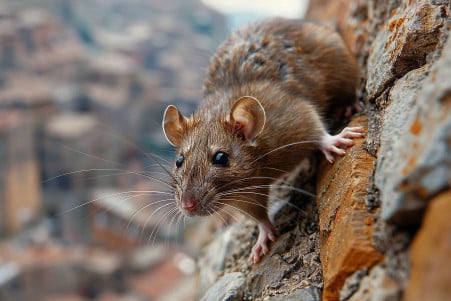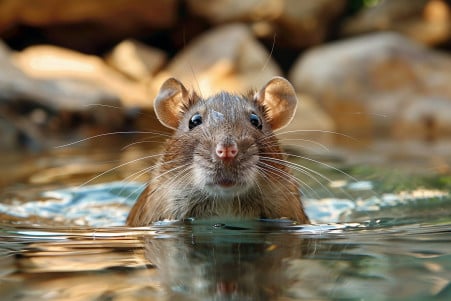Do Rats Have Bones? Exploring Rodent Skeletal Structure
9 February 2024 • Updated 8 February 2024

Rats’ amazing ability to wiggle through the tiniest of spaces has led many people to wonder if they even have bones. The truth is, rats do have a skeletal system made up of bones, joints, and cartilage. However, despite popular belief, rats don’t have a collapsible skeleton; instead, their bodies are long and flexible, and they don’t have collarbones, which makes it possible for them to squeeze through small spaces.
In this article, we’ll take a deep dive into the world of rat anatomy, drawing on research from veterinary science, zoology, and comparative biology. We’ll look at research on the composition and flexibility of rat bones, as well as the relationship between the muscular and skeletal systems.
Our goal is to shed light on how rats are able to move through their world with such flexibility and resilience. So let’s take a closer look at rat physiology, and in the process, we’ll give you more information than you ever thought you needed about whether or not rats have bones.
Do rats have bones?
Anatomy of the Rat Skeleton
The rat’s skeleton is a highly complex system that has evolved to give the animal the greatest amount of flexibility and versatility.
The basic structure of the rat’s skeleton is similar to that of other mammals, with bones connected by joints and cartilage.
A visual representation from the Visual Dictionary shows that the main bones of the rat include the rib cage, spine, and limbs, which include the femur and tibia in the hind limbs, and the humerus, radius, and ulna in the forelimbs. The rat’s skeleton is made up of bones of all sizes, from the long femur to the small phalanges that make up the bones of the toes.
The bones of the rat are essential to the animal’s ability to carry out its physical functions. For example, the rat’s lack of a collarbone is what allows it to fit through small spaces, a critical ability in the wild. The rat’s skeleton is strong and flexible, allowing it to climb, dig, and run with great speed and agility.
Some myths about the rat’s skeleton, such as the idea that it is collapsible, are debunked by the fact that rats, like all vertebrates, have a set number of bones.
According to Wildlife Removal, rats’ ability to fit through small spaces is not due to collapsible bones but to their body shape and strong legs. Understanding the basic anatomy of the rat’s skeleton helps to set the stage for understanding the bones’ physical properties, such as density and strength, that help the rat survive and thrive.
Bone Density and Strength in Rats
Rats depend on bone density and strength for their survival and adaptability. Not only do these physical traits help them move with agility, but they also help them withstand a variety of environmental stressors.
A study by Steven Boonen in Endocrinology found that rat bones have a number of differences in composition and density when compared to other vertebrates commonly used in research, including humans and dogs. For example, rat bone has a higher ash content and a higher concentration of insulin-like growth factor-I, both of which contribute to the unique quality and strength of rat bones.
These findings have important implications for the survival of rats, given their ability to live and thrive in a variety of, sometimes extreme, environments. Fracture stress, which is a measure of bone strength, is important for their burrowing and climbing, while bone density contributes to their overall strength.
To study these traits in rats, researchers use methods like densitometry and mechanical testing. A study by Denis M. Larkin in ScienceDirect found that dietary factors, including calcium and iron levels, can impact bone morphology, strength, and density. This is important for rat health and their use as a model in osteoporosis research, as shown in a study by Pavlos P. Lelovas in PubMed.
This research into rat bone density and strength helps to further our understanding of their physiological abilities and provides a foundation for future research into the evolutionary adaptations that have helped rats become such successful survivors in the animal kingdom.
Evolutionary Adaptations of Rat Skeletal Structure
The rat’s skeleton has evolved as a result of a complex interplay between environmental demands and genetic influences. As a result, rats have been shaped by evolution to become highly adaptable creatures that can thrive in a wide range of environments.
One study published in Genome Biology and Evolution even describes the genetic adaptations of New York City rats, which demonstrates how urban environments have influenced their evolution, including skeletal changes that help them move through human-made landscapes.
For example, skeletal adaptations like denser bones for burrowing or lighter bones for climbing have helped rats conquer environments as different as sewers and skyscrapers. An overview in Britannica emphasizes the long evolutionary history and wide variety of rodent skeletons, which have been adapted to fill a wide range of ecological niches. This is shown by the rat’s ability to live in everything from rural to urban environments.
The connection between rat behaviors and skeletal evolution is demonstrated by urban rats, which have evolved traits that help them survive in the face of human expansion. One study in Biology Letters describes rats that lack molars, a surprising adaptation that suggests a change in diet and gnawing behavior, both of which are likely the result of the resources available in their environment.
Recognizing these evolutionary subtleties helps us understand how the interplay between rat skeletal muscles and bones has helped them become so adaptable. This adaptability is based on the inherent flexibility and strength of their bones.
Muscle-Bone Crosstalk in Rats
The muscle–bone crosstalk in rats is important for their speed and agility. The skeletal muscles in rats are attached to the bones, which allows them to move and is responsible for their unique agility.
The relationship between the development of these muscles and the skeletal system is complex and important. A study published in PubMed by T. Tamaki explains that the rapid increase in muscle mass during the postnatal growth period in rats is due to both longitudinal and transverse growth, which is an increase in the number of sarcomeres, the contractile units in each muscle fiber.
Another study by Qian Zhang in BMC Musculoskeletal Disorders looks at muscle-bone crosstalk and how changes in one tissue can affect the other. This study shows that androgen levels have a significant impact on both bone mineral density and muscle strength, which suggests that there is a relationship between muscle and bone health.
An article in PMC on the biomechanical aspects of muscle-bone interaction also supports this crosstalk by explaining that muscle and bone tissues adapt to each other’s changes.
Understanding these relationships helps to explain how rats are able to achieve their incredible locomotor abilities and may have implications for human medicine, including treatments for muscle and bone loss. This complex relationship also sets the stage for a deeper look at how bone biomechanics allow rats to perform complex movements in a variety of environments.
Biomechanics of Rat Bones
Biomechanical properties of rat bones are important for understanding how rats are able to move with such agility. As one study in Scientific Reports notes, the rat hindlimb is commonly used in research for a variety of medical issues, and this is important for the role it plays in the translational potential of regenerative therapeutics.
The skeletal system, especially the hindlimbs, enables rats to perform complex movements like over-ground walking, which is important for climbing and burrowing.
The flexibility of the skeletal system is a key reason why rats are so agile. As a study in the International Journal of Design & Nature and Ecodynamics explains, rats alter their gait and speed to deal with increasing limb joint torques and powers during inclined locomotion, which is a clear example of the adaptive nature of their skeletal system.
These biomechanical properties have even been used in the development of the climbing robot Rat-Nic, which was created after a detailed analysis of rat locomotion. The way rat bone biomechanics and their ability to navigate through complex environments are interlinked is a confirmation of their evolutionary success, which has enabled them to adjust and inhabit a wide variety of environments.
Rat Anatomy: A Summary
In this detailed examination of the rat’s skeletal system, we have shown that the rat’s bones are indeed strong, with a unique structure and high density. These are the result of evolutionary pressures that have favored speed and endurance, and they have helped to make the rat one of the most successful mammals on the planet.
The wonder of biological evolution is evident in the way the rat’s skeletal system works in conjunction with its muscular system to enable the rat to move with speed and agility. Rat anatomy is a clear demonstration of the power of evolution and natural selection, showing how organisms adapt to and change their environments.
Our study also shows that understanding rat anatomy has important implications for science. Knowledge of the rat’s bones and muscles can be used to further medical and technological research.
By understanding the full range of the rat’s skeletal system, we can gain insights that can be used in biological and engineering research to further our understanding of animal physiology and possible human uses. This information can be used as a foundation for future studies and the development of new technologies.


